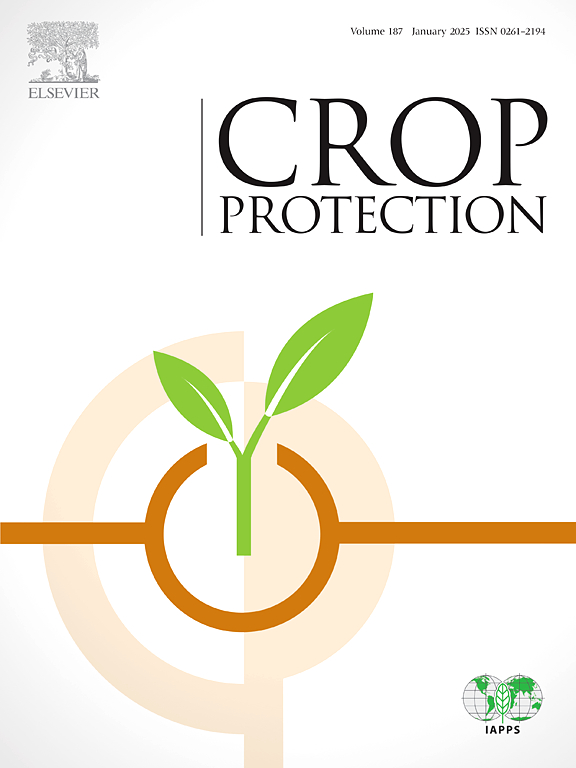Development and effectivity of Solanum sisymbriifolium against potato cyst nematode under field conditions in soils from the southern atlantic area
IF 2.5
2区 农林科学
Q1 AGRONOMY
引用次数: 0
Abstract
Potato cyst nematodes (PCNs), belonging to the genus Globodera spp., are spread worldwide constituting a problem of concern as they can cause considerable losses in crop yields. An alternative to the application of common pesticides is the use of trap crops, that promote the hatching of second-stage juvenile cysts without supporting the feeding and reproduction of these nematodes. For this purpose, in recent years, there has been growing attention to the use of Solanum sisymbriifolium as a biopesticide. In this study, we focused on looking for the best conditions to grow this trap crop under field conditions, contrary to previous studies developed in pots under controlled conditions. Various management strategies, including sowing date and depth, irrigation and soil compaction, to grow S. sisymbriifolium in acid sandy soils (pH 4.3–5.5) have been evaluated. In addition, the efficiency of S. sisymbriifolium was tested under field conditions in three PCN-infested plots. The results indicate that the best conditions for S. sisymbriifolium cropping in South Atlantic latitudes included sowing dates in July and August at 10–15 cm depth, with irrigation and soil compaction after sowing. Under these conditions, a 77%–89% decrease in PCNs was observed with a high initial number of cysts (93–160 per 100g), and even some sub-plots showed a 100% reduction when the initial number of cysts was low (15–52 per 100g). Therefore, S. sisymbriifolium could be an interesting substitute for unspecific chemical nematicides in potato crops to promote sustainable agriculture.
在南大西洋地区的土壤中,茄属植物在田间条件下的发展和抗马铃薯胞囊线虫的效果
马铃薯胞囊线虫(PCNs)属于 Globodera spp.属,遍布全球,是一个令人担忧的问题,因为它们会给作物产量造成巨大损失。除施用普通杀虫剂外,还有一种替代方法就是使用诱捕作物,这种作物能促进第二阶段幼囊的孵化,而不支持这些线虫的进食和繁殖。为此,近年来越来越多的人开始关注使用茄属植物作为生物杀虫剂。在这项研究中,与之前在控制条件下进行的盆栽研究不同,我们的重点是寻找在田间条件下种植这种诱捕作物的最佳条件。我们评估了在酸性砂质土壤(pH 值为 4.3-5.5)中种植 S. sisymbriifolium 的各种管理策略,包括播种日期和深度、灌溉和土壤压实。此外,还在三块多氯化萘污染地块的实地条件下测试了 S. sisymbriifolium 的生长效率。结果表明,在南大西洋纬度地区种植 S. sisymbriifolium 的最佳条件包括:播种日期为 7 月和 8 月,播种深度为 10-15 厘米,播种后进行灌溉和土壤压实。在这些条件下,当孢子囊初始数量较多(每 100 克 93-160 个)时,多核苷酸的降幅为 77%-89%;当孢子囊初始数量较少时(每 100 克 15-52 个),一些小地块的多核苷酸降幅甚至达到了 100%。因此,S. sisymbriifolium 可以替代马铃薯作物中的非特异性化学杀线虫剂,促进农业可持续发展。
本文章由计算机程序翻译,如有差异,请以英文原文为准。
求助全文
约1分钟内获得全文
求助全文
来源期刊

Crop Protection
农林科学-农艺学
CiteScore
6.10
自引率
3.60%
发文量
200
审稿时长
29 days
期刊介绍:
The Editors of Crop Protection especially welcome papers describing an interdisciplinary approach showing how different control strategies can be integrated into practical pest management programs, covering high and low input agricultural systems worldwide. Crop Protection particularly emphasizes the practical aspects of control in the field and for protected crops, and includes work which may lead in the near future to more effective control. The journal does not duplicate the many existing excellent biological science journals, which deal mainly with the more fundamental aspects of plant pathology, applied zoology and weed science. Crop Protection covers all practical aspects of pest, disease and weed control, including the following topics:
-Abiotic damage-
Agronomic control methods-
Assessment of pest and disease damage-
Molecular methods for the detection and assessment of pests and diseases-
Biological control-
Biorational pesticides-
Control of animal pests of world crops-
Control of diseases of crop plants caused by microorganisms-
Control of weeds and integrated management-
Economic considerations-
Effects of plant growth regulators-
Environmental benefits of reduced pesticide use-
Environmental effects of pesticides-
Epidemiology of pests and diseases in relation to control-
GM Crops, and genetic engineering applications-
Importance and control of postharvest crop losses-
Integrated control-
Interrelationships and compatibility among different control strategies-
Invasive species as they relate to implications for crop protection-
Pesticide application methods-
Pest management-
Phytobiomes for pest and disease control-
Resistance management-
Sampling and monitoring schemes for diseases, nematodes, pests and weeds.
 求助内容:
求助内容: 应助结果提醒方式:
应助结果提醒方式:


